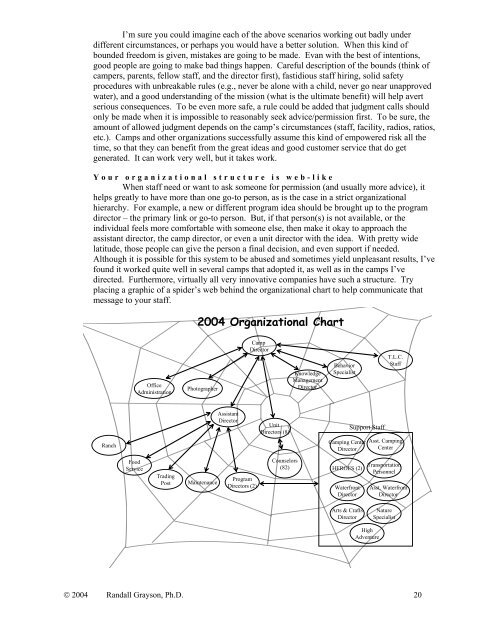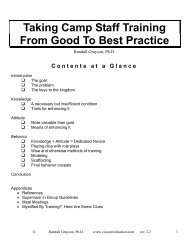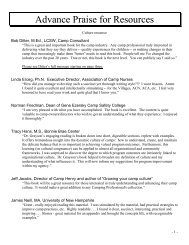Staff motivation - Vision Realization
Staff motivation - Vision Realization
Staff motivation - Vision Realization
You also want an ePaper? Increase the reach of your titles
YUMPU automatically turns print PDFs into web optimized ePapers that Google loves.
I’m sure you could imagine each of the above scenarios working out badly under<br />
different circumstances, or perhaps you would have a better solution. When this kind of<br />
bounded freedom is given, mistakes are going to be made. Evan with the best of intentions,<br />
good people are going to make bad things happen. Careful description of the bounds (think of<br />
campers, parents, fellow staff, and the director first), fastidious staff hiring, solid safety<br />
procedures with unbreakable rules (e.g., never be alone with a child, never go near unapproved<br />
water), and a good understanding of the mission (what is the ultimate benefit) will help avert<br />
serious consequences. To be even more safe, a rule could be added that judgment calls should<br />
only be made when it is impossible to reasonably seek advice/permission first. To be sure, the<br />
amount of allowed judgment depends on the camp’s circumstances (staff, facility, radios, ratios,<br />
etc.). Camps and other organizations successfully assume this kind of empowered risk all the<br />
time, so that they can benefit from the great ideas and good customer service that do get<br />
generated. It can work very well, but it takes work.<br />
Your organizational structure is web-like<br />
When staff need or want to ask someone for permission (and usually more advice), it<br />
helps greatly to have more than one go-to person, as is the case in a strict organizational<br />
hierarchy. For example, a new or different program idea should be brought up to the program<br />
director – the primary link or go-to person. But, if that person(s) is not available, or the<br />
individual feels more comfortable with someone else, then make it okay to approach the<br />
assistant director, the camp director, or even a unit director with the idea. With pretty wide<br />
latitude, those people can give the person a final decision, and even support if needed.<br />
Although it is possible for this system to be abused and sometimes yield unpleasant results, I’ve<br />
found it worked quite well in several camps that adopted it, as well as in the camps I’ve<br />
directed. Furthermore, virtually all very innovative companies have such a structure. Try<br />
placing a graphic of a spider’s web behind the organizational chart to help communicate that<br />
message to your staff.<br />
Ranch<br />
Food<br />
Service<br />
Office<br />
Administration<br />
Trading<br />
Post<br />
2004 Organizational Chart<br />
Photographer<br />
Maintenance<br />
Assistant<br />
Director<br />
Program<br />
Directors (2)<br />
Camp<br />
Director<br />
Unit<br />
Directors (8)<br />
Counselors<br />
(82)<br />
Knowledge<br />
Management<br />
Director<br />
Behavior<br />
Specialist<br />
Camping Center<br />
Director<br />
HEROES (2)<br />
Waterfront<br />
Director<br />
Arts & Crafts<br />
Director<br />
Support <strong>Staff</strong><br />
High<br />
Adventure<br />
Transportation<br />
Personnel<br />
© 2004 Randall Grayson, Ph.D. 20<br />
T.L.C.<br />
<strong>Staff</strong><br />
Asst. Camping<br />
Center<br />
Asst. Waterfront<br />
Director<br />
Nature<br />
Specialist





